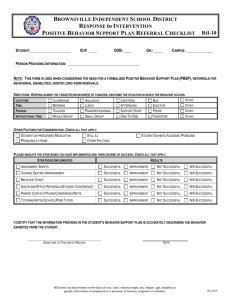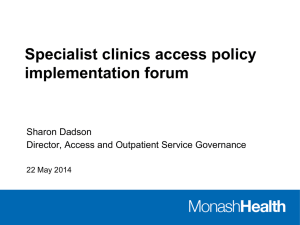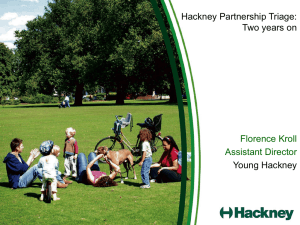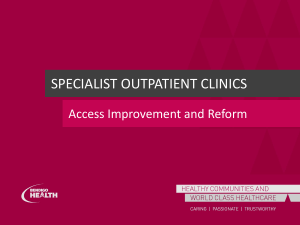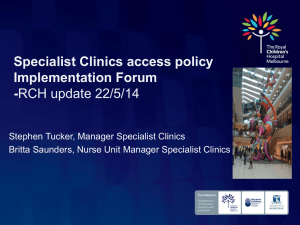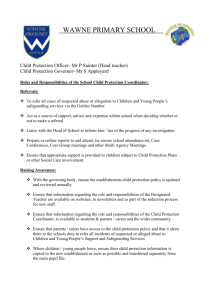Integrated Therapy Service - Somerset children & young people
advertisement
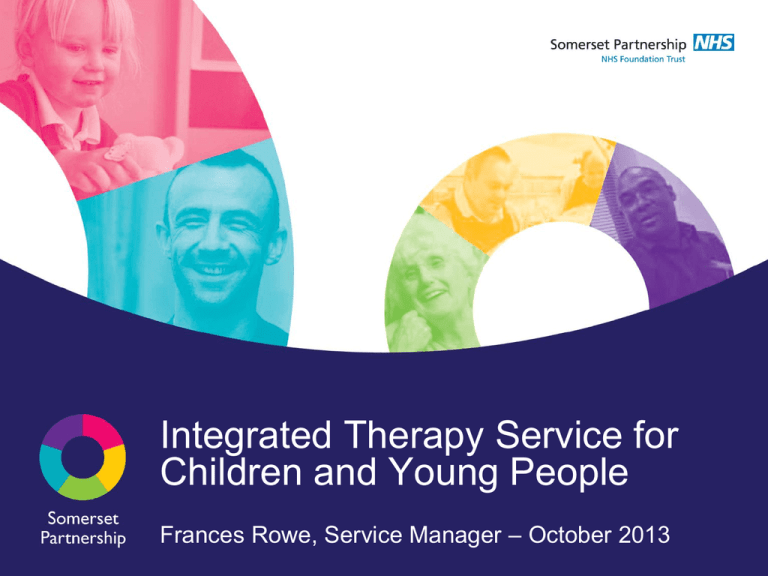
Integrated Therapy Service for Children and Young People Frances Rowe, Service Manager – October 2013 History of the ITS • Previously – 4 separate Health Trusts provided Paediatric Speech and Language Therapy, Occupational Therapy and Physiotherapy: complex patchwork of provision, different models of access/waiting times/delivery • October 2009: Integrated Therapy Service commissioned by Somerset Primary Care Trust working with Somerset Local Authority • ITS provides: SLT, OT and PT to whole county: babies, children and young people, 0 – 19 years, in an equitable and integrated model • Venues: ITS clinics, Children’s Centres and pre-schools, mainstream and special schools, family homes, hospital wards and consultant outpatient clinics • Integrated Area Teams: Taunton, Bridgwater, Yeovil and Wells Sources of referrals to the ITS Source Percentage Medical Consultants 23% Schools 23% Health Visitors 21% GPs 9% Pre-school settings 8% Education services 6% External therapists 4% Parents/carers 3% Internal referrals 2% CAMHS 1% TOTAL 100% Typical referral percentages per year by therapy/age range Therapy Age Range Percentage Occupational Therapy 0 – 4 years 5.6% 5 – 19 years 16.6% Total for OT 22.2% 0 – 4 years 10.2% 5 – 19 years 10.1% Total for PT 20.3% Physiotherapy Speech and Language Therapy 0 – 4 years Total for service 34.3% 5 – 19 years 23.2% Total for SLT 57.5% 100% Model • Single Point of Access – for all referrals • Clinical triage – by experienced therapists. Referrals accepted / rejected as inappropriate / signposted to more appropriate provision / further information requested within 20 working days to enable triage • Telephone Advice Line – open 09:00 to 12:00, Monday, Wednesday, Thursday and Friday, staffed by experienced SLT, OT and PT. Provides advice and guidance, with potential acceptance of verbal referral. Tel: 0303 033 3002 • Reduced maximum waiting time – below 13 weeks from end of March 2012 onwards, despite increase in referrals Model Assessment – generally at area team clinics/other venues where appropriate. Subsequent appointments often in child’s preschool setting, school or home. May highlight a goal the ITS can help child achieve by providing a form of intervention. • • • • • Intervention – depending on child's needs and difficulties, one or more of following options may be agreed with parents/carers and/or setting: advice and recommendations for achieving agreed goal programme of therapy activities to be carried out at home and/or setting training of parents or professionals to meet CYP's needs review to check CYP’s progress after a few months block of individual or group therapy sessions Discharge – when involvement of the ITS is not currently required, discussed and agreed with the parents/carers. GP/other involved professionals notified. Model • Aim: to provide the wider children’s workforce and families with the knowledge, skills and confidence to - support children with lower levels of need in their daily activities - prevent their problems increasing - help them make accelerated progress - identify the children who need specialist assessment & support: The Fact File for Early Years (0 – 4 years) The Fact File for School Age (5 – 19 years) Fact File for Early Years Fact File for Early Years contains information on how to: • Help children’s development in the areas covered by Speech and Language Therapy, Occupational Therapy and Physiotherapy • Identify common and acceptable variations in young children’s development • Decide which children need additional support to promote their development by providing: • Practical Advice Sheets which professionals can use and share with parents • Guidance on when and how to refer for specialist assessment by the ITS Fact File for School Age Fact File for School age contains information on: • Typical development of school age children and young people in the areas covered by SLT, OT and PT • How to identify common and acceptable variations in CYP’s development • How to decide which CYP may need additional support to promote their development by providing: • Practical Advice Sheets to use and share with parents/carers • Guidance on when and how to refer for specialist assessment by the ITS Where to find out more about the ITS ITS website provides: • Information on the service – for professionals and parents/carers • Contact details for the area teams • How to refer, including contact details for the Single Point of Access and all referral forms • Details of the Telephone Advice Line • Printable copies of the Fact File for Early Years and Fact File for School Age • Printable copies of all Advice Sheets in the Fact Files: http://www.sompar.nhs.uk/our_services/childrenandyoungpeople /integrated_therapy_service/ Current evaluation Evaluation is underway of user experience and effectiveness of: • Telephone Advice Line – telephone questionnaire with sample of users • Fact File for Early Years – written questionnaire to Health Visitors • Fact File for School Age – written questionnaire to school SENCos Results currently being collated and analysed. Generally very positive with some helpful suggestions for further development Ensuring ITS is as effective as possible within resources • Requirement for specific information at referral, using guidance in the Fact Files • Careful triage of referrals – to ensure appropriateness • Close monitoring of referral rates and management of assessment clinics • Revision and streamlining of all paperwork e.g. clinical reports • Personalised and agreed care planning, evaluation of outcomes • Discharge if active intervention not needed, clear guidance on re-referral and use of Telephone Advice Line • Flexible workforce moving where needed Ongoing challenges / responses • Ongoing rise in referrals since service commissioned in October 2009 Referrals in Jan – Dec 2009: 2,180 Referrals in Jan – Dec 2012: 3,888 Increase of 78% No additional funding, no evidence of reduction in referrals during 2013 • Increased complexity – in the needs of children who require ongoing ITS support: medical, developmental and social • Capacity of partner services and agencies – to support agreed care plans and therapy programmes Response Next steps... • Revision of the core service – what will be provided • Revision of the care pathways and levels of intervention for different needs • Development of high quality, evidence based Therapy Guidance Sheets on managing complex needs for children with assessed and diagnosed conditions • Provision of traded services to providers and settings who have requested additional therapy provision ...work in progress
